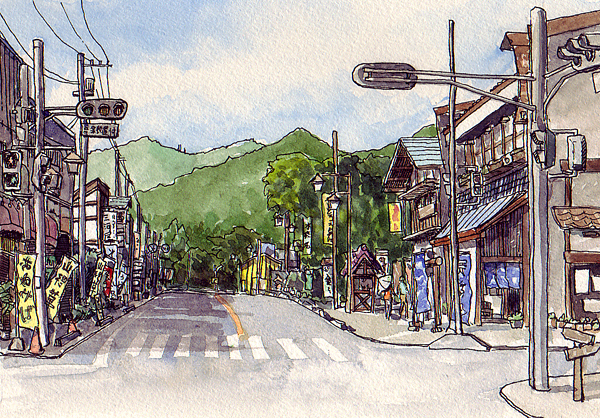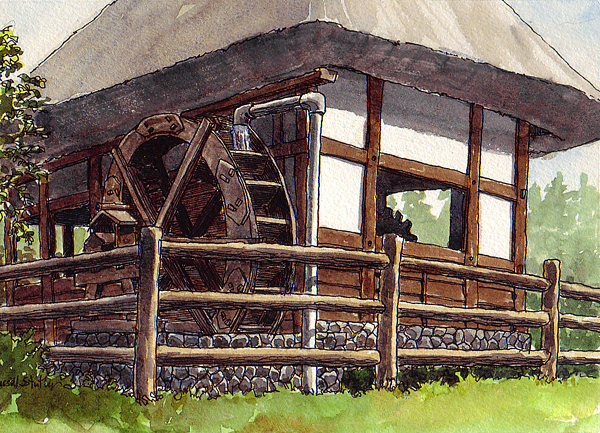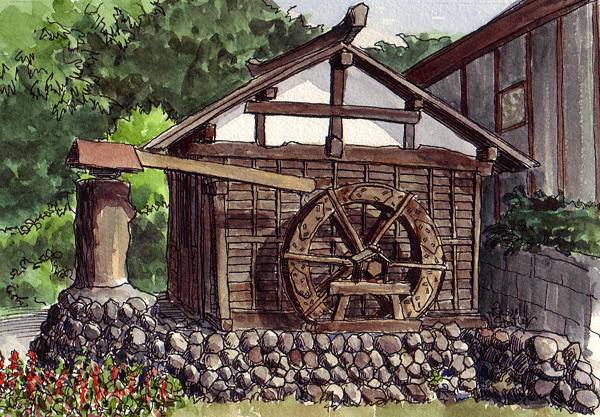 | ||
|
Back in Gunma prefecture (August, 2006) In early August of 2006 our family went back to visit my wife's hometown in Gunma prefecture. The town is called Sarugakyo, and is very small. It used to be a thriving hot spring town. The hot springs are still there, but the number of visitors has dwindled. Fortunately, the summer brings bus loads of atheletes from high schools and colleges who hold various sports camps at the several remaining hotels here.  The first morning I went to one end of the main street (there are really no other streets) and sat down in a shady spot to sketch everything before me. Unfortunately my shade gradually shrank, and I ended up sitting in the hot summer sun after about an hour. There were many huge buses rumbling through, and whenever one stopped at a red light in front of me, obliterating my view, I quickly stood up and went over to a shady spot nearby for a break. You can see all the way to the end of the street where it suddenly curves to the right and goes off into the mountains and on to Niigata prefecture. Whenever I visit this town I find another business has closed up. In the past few years they have lost their only convenience store, their only gas station, a restaurant and a special coffee shop (all located at the far end of this street scene). Now there are only a few restaurants, hot springs and souvenir shops with their colorful banners waving in front. Such a peaceful place. I hope it doesn't vanish. The "saru" in Sarugakyo means monkey, and there are lots of wild monkeys around -- and they love the pumpkin crops that the folks here work so hard to cultivate. It wouldn't be so bad if the monkeys finished one pumpkin before starting the next one, but they prefer to take a bite from each pumpkin and then toss it aside. Monkeys have no manners. I went down a narrow back street in the afternoon and found a water mill that was actually in operation. It was fed water from a pipe, and turned a gear inside the little building that caused a mill stone to grind grain. There are a pair of mill stones, and the top one rotates, grinding grain on the bottom one. Also, the axel of the wheel has wooden planks attached which raise vertical posts and allow them to drop down again. These are apparently for pounding mochi rice into rice cakes.  At the time I was sketching this, the gears were disengaged, so the wheel simply turned for the sake of turning. I sat on the other side of the narrow road and sketched while fighting off huge deerflies. I discovered that a hard spiral bound sketchbook is a great weapon in these situations, allowing you to swat these attackers from the air as they circle around you, buzzing in and out, looking for a way to get past your defenses. I always make sure to close the sketchbook before I take a swing, and the hard cover makes a gratifying sound as I bat them out of the air (I never see them again after that). As a matter of fact, these guys were so persistent, I always kept my sketchbook in my hand when I hiked, not so much for sketching, but for defense. The next day I visited a village in the mountains called "Takumi no Sato" which was populated by various artists and craftsmen selling their work, and giving lessons to folks who stopped in. It was sort of a tourist village, but being located in such a remote place, there were only Japanese visitors. It must be one of those secret spots popular with the Japanese, but unknown to the outside world. There were many big old traditional Japanese country houses, and in the middle of this town was yet another water wheel, the third I have seen in Gunma. This one was also fully working, and attached to a pair of millstones inside the small building. The water came up through a pipe in the center of the tree stump on the left.  Across the street was a small tea shop with two picnic tables out front. Since it was beastly hot, nobody cared to sit out there in the sun. Unlike the day before, the shade from the building behind me eventually grew, and I only had to put up with the sun for the first hour or so. I ordered ice tea (several in a row, actually) and sat at one of these tables and proceeded to sketch. No deerflies here, but lots of families stopping to watch or ask questions. Several parents had to stop their kids from climbing up on my table. I think I prefer the deerflies. At least I can whomp them with my sketchbook. Still, with my growing shade and the perpetual supply of ice tea, this was a pleasant experience. All the sketches on this page were drawn with fountain pen and Platinum carbon ink, and colored with watercolors using a Kuretake waterbrush. I mentioned on the previous page my love for ultramarine and burnt sienna combinations. Here is my current palette which I use for all my watercolors. It consists of 12 colors:
You will notice that all of these are single pigment colors except one, so there are less surprises when mixing. Two of these colors use the exact same pigment, but the hues are very different! I have tried as far as possible to stick with Holbein colors since they are made here in Japan and are much lower in price than Winsor & Newton. One of these colors, Peacock Blue PB17, is apparently only made by Holbein! However, I had to go with Winsor & Newton for a few colors because they were not available by Holbein, or because Holbein's equivalent was unacceptable. I wanted to get a neutral yellow for mixing since my palette only has one yellow, and chose PY97 based on recomendations found at Handprint.com. Holbein does not make a watercolor with PY97 (I even contacted them and requested it, but they politely said no) so I chose Winsor & Newton. However, even Winsor & Newton has discontinued it, so I have bought up every tube I could find in Tokyo, and will have to find a replacement yellow (Handprint also recommends PY154) when these run out. I'll probably chose Winsor & Newton's Winsor Yellow (PY154) since Holbein does not make a yellow paint with this pigment either. Regarding PV19, Holbein does make a watercolor with this pigment called Permanent Magenta but it is very dull and disappointing compared to Winsor & Newton's Permanent Rose. The other Winsor & Newton color I have chosen is sap green. It's also the only color that is not a single pigment. I can't live without my sap green, and the Holbein version is much brighter and exciting (it really turns me on, artistically speaking). However it is also fugitive (not lightfast) so I settled for the not-as-exciting but more faithful Winsor & Newton. Having said that, I have discovered I can get a nice sap green replacement that is more exciting than the Winsor & Newton and comes close to the Holbein version. I get it by mixing PY97, PG36 and PR108 (Cadmium Yellow Orange). So when my tube of sap green runs out, I won't be replacing it, and all my colors will be single pigment. I need to say a little about Shadow Green by Holbein (PBK31) since it is not a usual choice for a small palette. Apparently Holbein used to make this color by mixing lamp black with PBK31, but now they use straight PBK31 which is a very dark green, almost black. And I prefer single pigment colors, as you know. It is perfect for those very dark parts of trees that are in shadow, and if you mix it with PV19 you can get a nice black. These twelve colors do everything I want. Sometimes the mixtures of these colors are more exciting than any convenience color. For example, the combination of PY97 and PB17 make a vibrant yellow green for early spring leaves that no tube green can match. Twelve colors and a waterbrush. What could be more portable? |
Next page >> |
 |
 |